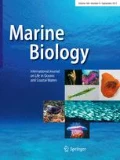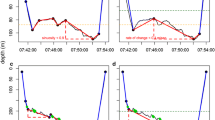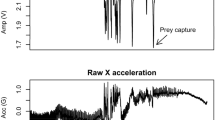Abstract
The identification of feeding events is crucial to our understanding of the foraging ecology of seabirds. Technology has made small devices, such as time-depth recorders (TDRs) and accelerometers available. However, TDRs might not be sensitive enough to identify shallow dives, whereas accelerometers might reveal more subtle behaviours at a smaller temporal scale. Due to the limitations of TDRs, the foraging ecology of many shallow-diving seabirds has been poorly investigated to date. We thus developed an algorithm to identify dive events in a shallow-diving seabird species, the Scopoli’s shearwater, using only accelerometer data. The accuracy in the identification of dives using either accelerometers or TDRs was compared. Furthermore, we tested if the foraging behaviour of shearwaters changed during different phases of reproduction and with foraging trip type. Data were collected in Linosa Island (35°51′33″N; 12°51′34″E) from 12 June to 8 September 2015 by deploying accelerometer data loggers on 60 Scopoli’s shearwaters. Four birds were also equipped with TDRs. TDRs recorded only 17.7% of the dives detected by the accelerometers using the algorithm. A total of 82.3% of dives identified by algorithm were too short or shallow to be detected by TDRs. Therefore, TDRs were not accurate enough to detect most of the dives in Scopoli’s shearwaters, which foraged mostly close to the sea surface. Our data showed that birds performed shorter foraging trips and dived more frequently in the early chick-rearing period compared with the late chick-rearing and incubation phases. Furthermore, parents dived more frequently during short foraging trips. Our results suggest that Scopoli’s shearwaters maximised their foraging effort (e.g. number of dives, short trips) during shorter foraging trips and during early chick-rearing.





Similar content being viewed by others
References
Arcos JM, Oro D (2002) Significance of fisheries discards for a threatened Mediterranean seabird, the Balearic shearwater Puffinus mauretanicus. Mar Ecol Prog Ser 239:209–220. doi:10.3354/meps239209
Ashmole NP (1971) Seabird ecology and the marine environment. In: Farner DS, King JR (eds) Avian biology. Academic Press, New York, pp 223–286
Baduini CL, Hyrenbach KD (2003) Biogeography of procellariiform foraging strategies: does ocean productivity influence provisioning? Mar Ornithol 31:101–112
Berlincourt M, Angel LP, Arnould JPY (2015) Combined use of GPS and accelerometry reveals fine scale three-dimensional foraging behaviour in the short-tailed shearwater. PLoS One 10:1–16. doi:10.1371/journal.pone.0139351
Bolton M (1996) Energy expenditure, body weight and foraging performance of Storm Petrels Hydrobates pelagicus breeding in artificial nesting chambers. Ibis 138(3):405–409
Cecere JG, Catoni C, Maggini I, Imperio S, Gaibani G (2013) Movement patterns and habitat use during incubation and chick-rearing of Cory’s shearwaters (Calonectris diomedea diomedea) (Aves: Vertebrata) from Central Mediterranean: influence of seascape and breeding stage. Ital J Zool 80:82–89. doi:10.1080/11250003.2012.710654
Cecere JG, Gaibani G, Imperio S (2014) Effects of environmental variability and offspring growth on the movement ecology of breeding scopoli’s shearwater Calonectris diomedea. Curr Zool 60:622–630. doi:10.1093/czoolo/60.5.622
Chimienti M, Cornulier T, Owen E, Bolton M, Davies IM, Travis JM, Scott BE (2016) The use of an unsupervised learning approach for characterizing latent behaviors in accelerometer data. Ecol Evol 6(3):727–741. doi:10.1002/ece3.1914
Congdon BC, Krockenberger AK, Smithers BV (2005) Dual-foraging and coordinated provisioning in a tropical Procellariiform, the wedge-tailed shearwater. Mar Ecol Prog Ser 301:293–301. doi:10.3354/meps301293
Dias MP, Granadeiro JP, Catry P (2012) Working the day or the night shift? Foraging schedules of Cory’s shearwaters vary according to marine habitat. Mar Ecol Prog Ser 467:245–252. doi:10.3354/meps09966
Gleiss AC, Wilson RP, Shepard ELC (2011) Making overall dynamic body acceleration work: on the theory of acceleration as a proxy for energy expenditure. Methods Ecol Evol 2:23–33. doi:10.1111/j.2041210X.2010.00057.x
Gómez Laich A, Wilson RP, Gleiss AC, Shepard EL, Quintana F (2011) Use of overall dynamic body acceleration for estimating energy expenditure in cormorants. J Exp Mar Bio Ecol 399:151–155. doi:10.1016/j.jembe.2011.01.008
Granadeiro J, Nunes M, Silva M, Furness R (1998) Flexible foraging strategy of Cory’s shearwater, Calonectris diomedea, during the chick-rearing period. Anim Behav 56:1169–1176. doi:10.1006/anbe.1998.0827
Grémillet D, Dell’Omo G, Ryan PG, Peters G, Ropert-Coudert Y, Weeks SJ (2004) Offshore diplomacy, or how seabirds mitigate intra-specific competition: A case study based on GPS tracking of Cape gannets from neighbouring colonies. Mar Ecol Prog Ser 268:265–279. doi:10.3354/meps268265
Grémillet D, Pichegru L, Kuntz G, Woakes AG, Wilkinson S, Crawford RJM, Ryan PG (2008) A junk-food hypothesis for gannets feeding on fishery waste. Proc R Soc Lond Biol 275:1149–1156. doi:10.1098/rspb.2007.1763
Grémillet D, Péron C, Pons J-B, Ouni R, Authier M, Thévenet M, Fort J (2014) Irreplaceable area extends marine conservation hotspot off Tunisia: insights from GPS-tracking Scopoli’s shearwaters from the largest seabird colony in the Mediterranean. Mar Biol 161:2669–2680. doi:10.1007/s00227-0142538-z
Guilford TC, Meade J, Freeman R, Biro D, Evans T, Bonadonna F, Boyle D, Roberts S, Perrins CM (2008) GPS tracking of the foraging movements of Manx shearwaters Puffinus puffinus breeding on Skomer Island, Wales. Ibis 150:462–473. doi:10.1111/j.1474-919x.2008.00805.x
Hertel F, Ballance L (1999) Wing ecomorphology of seabirds from Johnston Atoll. Condor 101:549–556
Jonsen ID, Flemmings JM, Myers RA (2005) Robust state–space modeling of animal movement data. Ecology 86:2874–2880. doi:10.1890/04-1852
Kelleher K (2005) Discards in the world’s marine fisheries: an update. FAO Fish Tech Pap 470:131
Lo Valvo M (2001) Sexing dult Cory’s shearwater by discriminant analysis of body measurements on Linosa Island (Sicilian Channel), Italy. Waterbirds 24:169–174.
Magalhães M, Santos R, Hamer K (2008) Dual-foraging of Cory’s shearwaters in the Azores: feeding locations, behaviour at sea and implications for food provisioning of chicks. Mar Ecol Prog Ser 359:283–293. doi:10.3354/meps07340
Massa B, Lo Valvo M (1986) Biometrical and biological considerations on the Cory’s shearwater Calonectris diomedea. In: Mediterranean Marine Avifauna. Springer, Berlin, pp 293–313
McNeil R, Drapeau P, Pierotti R (1993) Nocturnality in colonial waterbirds: occurrence, special adaptations, and suspected benefits. In: Power DM (ed) Current ornithology, vol 10. Plenum Press, New York, pp 187–246
Meier RE, Wynn RB, Votier SC, Grive MM, Rodriguez A, Maurice L, Van Loon EE, Jones AR, Suberg L, Arcos JM, Morgan G, Josey SA, Guilford T (2015) Consistent foraging areas and commuting corridors of the critically endangered Balearic shearwater Puffinus mauretanicus in the northwestern Mediterranean. Biol Conserv 190:87–97
Navarro J, González-solís J, Viscor G (2007) Nutritional and feeding ecology in Cory’s shearwater Calonectris diomedea during breeding. Mar Ecol Prog Ser 351:261–271. doi:10.3354/meps07115
Navarro J, Kaliontzopoulou A, Gonzàlez-Solìs J (2009) Sexual dimorphism in bill morphology and feeding ecology in Cory’s shearwater (Calonectris diomedea). Zoology 112:128–138. doi:10.1016/j.zool.2008.05.001
Ochi D, Oka N, Watanuki Y (2010) Foraging trip decisions by the streaked shearwater Calonectris leucomelas depend on both parental and chick state. J Ethol 313–321. doi:10.1007/s10164-009-01873
Paiva VH, Geraldes P, Ramírez I, Meirinho A, Garthe S, Ramos JA (2010a) Foraging plasticity in a pelagic seabird species along a marine productivity gradient. Mar Ecol Prog Ser 398:259–274. doi:10.3354/meps08319
Paiva VH, Geraldes P, Ramírez I, Meirinho A, Garthe S, Ramos JA (2010b) Oceanographic characteristics of areas used by Cory’s shearwaters during short and long foraging trips in the North Atlantic. Mar Biol 157:1385–1399. doi:10.1007/s00227-010-1417-5
Phalan B, Phillips RA, Silk JRD et al (2007) Foraging behaviour of four albatross species by night and day. Mar Ecol Prog Ser 340:271–286. doi:10.3354/meps340271
Pinaud D, Weimerskirch H (2005) Scale-dependent habitat use in a long-ranging central place predator. J Anim Ecol 74:852–863. doi:10.1111/j.1365-2656.2005.00984.x
Quillfeldt P, Masello JF, Hamer KC (2004) Sex differences in provisioning rules and honest signalling of need in Manx shearwaters, Puffinus puffinus. Anim Behav 68:613–620. doi:10.1016/j.anbehav.2003.12.002
R Core Team (2015) R: a language and environment for statistical computing. Version 3.2.1. R Foundation for Statistical Computing, Vienna. https://www.R-project.org/
Ramos JA, Moniz Z, Solá E, Monteiro LR (2003) Reproductive measures and chick provisioning of Cory’s shearwater Calonectris diomedea borealis in the Azores. Bird Study 50:47–54. doi:10.1080/00063650309461289
Ramos JA, Granadeiro JP, Phillips RA, Catry P (2009) Flight morphology and foraging behavior of male and female Cory’s shearwaters. Condor 111:424–432. doi:10.1525/cond.2009.090008
Rollinson DP, Dilley BJ, Ryan PG (2014) Diving behaviour of white-chinned petrels and its relevance for mitigating longline bycatch. Polar Biol 37(9):1301–1308. doi:10.1007/s00300-014-1521-y
Ronconi RA, Ryan PG, Ropert-Coudert Y (2010) Diving of great shearwaters (Puffinus gravis) in cold and warm water regions of the South Atlantic Ocean. PLoS One 5(11):e15508. doi:10.1371/journal.pone.0015508
Ropert-Coudert Y, Kato A, Wilson RP, Cannell B (2006) Foraging strategies and prey encounter rate of free-ranging Little Penguins. Mar Biol 149:139–148. doi:10.1007/s00227-005-0188-x
Rubolini D, Maggini I, Ambrosini R et al (2015) The effect of moonlight on Scopoli’s shearwater Calonectris diomedea colony attendance patterns and nocturnal foraging: a test of the foraging efficiency hypothesis. Ethology 121(3):284–299. doi:10.1111/eth.12338
Sakamoto KQ, Sato K, Ishizuka M, Watanuki Y, Takahashi A, Daunt F, Wanless S (2009) Can ethograms be automatically generated using body acceleration data from free-ranging birds? PLoS One 4:e5379. doi:10.1371/journal.pone.0005379
Sangster G, Collinson JM, Crochet PA, Knox AG, Parkin DT, Votier SC (2012) Taxonomic recommendations for British birds: eighth report. Ibis 154:874–883. doi:10.1111/j.1474-919X.2012.01273.x
Shaffer SA, Costa DP, Weimerskirch H (2003) Foraging effort in relation to the constraints of reproduction in free-ranging albatrosses. Funct Ecol 17:66–74. doi:10.1046/j.1365-2435.2003.00705.x
Shaffer A, Weimerskirch H, Scott D, et al. (2009) Spatio temporal habitat use by breeding Sooty shearwaters Puffinus griseus. Mar Ecol Prog Ser 391:209–220. doi:10.3354/meps07932
Shepard E, Wilson R, Halsey L, et al. (2008) Derivation of body motion via appropriate smoothing of acceleration data. Aquat Biol 4:235–241. doi:10.3354/ab00104
Signorell A (2015) DescTools: tools for descriptive statistics. R package version 0.99, p 15
Spear LB, Ainley DG, Walker WA (2007) Foraging dynamics of seabirds in the Eastern Tropical Pacific Ocean. Studies in Avian Biology Series 35: Cooper Ornithological Society, Norman
Stahl JC, Sagar PM (2000) Foraging strategies and migration of southern Buller’s albatrosses Diomedea b. bulled breeding on the Solander Is, New Zealand. J R Soc New Zeal 30:319–334. doi:10.1080/03014223.2000.9517625
Terauds A, Gales R (2006) Provisioning strategies and growth patterns of light-mantled sooty albatrosses Phoebetria palpebrata on Macquarie Island. Polar Biol 29:917–926. doi:10.1007/s00300-006-0133-6
Tremblay Y, Roberts AJ, Costa DP (2007) Fractal landscape method: an alternative approach to measuring area-restricted searching behavior. J Exp Biol 210:935–945. doi:10.1242/jeb.02710
Weimerskirch H (1998) How can a pelagic seabird provision its chick when relying on a distant food resource? Cyclic attendance at the colony, foraging decision and body condition in sooty shearwaters. J Anim Ecol 67:99–109. doi:10.1046/j.1365-2656.1998.00180.x
Weimerskirch H, Chastel O, Ackermann L, Chaurand T, Cuenot-Chaillet F, Hindermeyer X, Judas J (1994) Alternate long and short foraging trips in pelagic seabird parents. Anim Behav 472–476
Wilson RP, Wilson M-PTJ (1989) Tape: a package attachment technique for penguins. Wildl Soc Bull 17:77–79.
Ydenberg R, Welham C, Schmid-Hempel R (1994) Time and energy constraints and the relationships between currencies in foraging theory. Behav Ecol 5(1):28–34
Zavalaga CB, Halls JN, Mori GP, Taylor SA, Dell’Omo G (2010) At-sea movement patterns and diving behavior of Peruvian boobies Sula variegata in northern Perù. Mar Ecol Prog Ser 404:259–274. doi:10.3354/meps08490
Zotier R, Bretagnolle V, Thibault J-C (1999) Biogeography of the marine birds of a confined sea, the Mediterranean. J Biogeogr 26:297–313
Acknowledgements
We wish to thank all people who participated in the fieldwork: Lucie Michel, Paolo Becciu, Enrica Martorelli, Katrin Quiring, Wiebke Schaefer, and Giulia Bambini. Thanks to Giacomo Dell’Omo for field work logistic. The project was supported by Ornis italica, Deutsche Forschungsgemeinschaft (PQ 148/8 and PQ 148/17), and the LIFE11 + NAT/IT/000093 ‘Pelagic Birds’.
Author information
Authors and Affiliations
Corresponding author
Ethics declarations
Conflict of interest
The authors declare that they have no conflict of interest.
Consent was obtained from all participants of the study. All animals were sampled and/or treated according to the national legislation. The study was conducted under a permit issued by the Regione Siciliana and Assessorato Risorse Agricole e Alimentari.
Additional information
Responsible Editor: V. H. Paiva.
Reviewed by Undisclosed experts.
Electronic supplementary material
Below is the link to the electronic supplementary material.
Rights and permissions
About this article
Cite this article
Cianchetti-Benedetti, M., Catoni, C., Kato, A. et al. A new algorithm for the identification of dives reveals the foraging ecology of a shallow-diving seabird using accelerometer data. Mar Biol 164, 77 (2017). https://doi.org/10.1007/s00227-017-3106-0
Received:
Accepted:
Published:
DOI: https://doi.org/10.1007/s00227-017-3106-0




